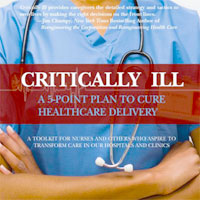Tag: research
Evaluation of a strategy for enrolling the families of critically ill patients in research using limited human resources
Family members were recruited for more than one third of eligible patients, and >90% of approached consented to participate. There are important demographic differences between patients with vs without an enrolled family... read more
Bacterial protein structure could aid development of new antibiotics
Bacterial cells have an added layer of protection, called the cell wall, that animal cells don't. Assembling this tough armor entails multiple steps, some of which are targeted by antibiotics like penicillin and vancomycin.... read more
New research shows why nutrition should be back on the table for surgical patients
More than 48 million people in the U.S. undergo surgery each year, and for decades the focus has been on making sure patients do not consume any food or drinks in the hours leading up to the surgery. Yet, 1 in 3 patients... read more
Critically Ill: A 5-Point Plan to Cure Healthcare Delivery
Two decades ago Dr. Fred Southwick witnessed the near demise of his wife while she was being cared for in a prominent academic medical center. For 15 years he blamed the individual physicians who cared for Mary. However five... read more

The Efficacy of ECMO for Severe ARDS
The H1N1 epidemic demonstrated that extracorporeal membrane oxygenation (ECMO) use in the most critically ill patients with acute respiratory distress syndrome (ARDS) resulted in a substantial decrease in mortality. The CESAR... read more
At the Root: Defining and Halting Progression of Early COPD
Chronic obstructive pulmonary disease (COPD) is a heterogeneous disorder with varying presentations and progression, but limited disease-modifying therapies. Trajectories of lung function decline in COPD differ significantly... read more
The Practice of Respect in the ICU
Although "respect" and "dignity" are intuitive concepts, little formal work has addressed their systematic application in the ICU setting. After convening a multidisciplinary group of relevant experts, we undertook a review... read more
Intravenous Iron, Not Oral, Improves Functional Capacity in HF Patients
The oral iron supplement failed to be absorbed, while the successful IV formulation is not without significant logistical and cost issues. In one study testing a convenient and easy-to-use oral iron supplement, investigators... read more
Clinical Trial Participants’ Views of the Risks and Benefits of Data Sharing
In a survey of participants in clinical trials, most believe the potential benefits of data sharing outweigh potential negative consequences and are willing to share their data. Less than 8% of respondents felt that the potential... read more
Automated System Detects Risk of VAP
Approximately 50 percent of all patients receiving mechanical ventilator support develop ventilator-associated pneumonia (VAP). Researchers at Massachusetts General Hospital (MGH) have developed an automated system for identifying... read more
Association of the Quick Sequential (Sepsis-Related) Organ Failure Assessment (qSOFA) Score With Excess Hospital Mortality in Adults With Suspected Infection in Low- and Middle-Income Countries
In this retrospective secondary analysis of 9 diverse LMIC cohorts that included 6569 hospitalized adults with suspected infection, a qSOFA score greater than or equal to 2 was significantly associated with increased likelihood... read more
Ten Shortcomings of the Current Definition of AKI
Acute kidney injury (AKI) is defined as an abrupt decline in kidney function. Although the kidney has many functions, this "abrupt decline" mostly refers to the glomerular filtration rate (GFR) that cannot... read more
Sepsis patients treated and released from emergency departments do well with outpatient follow-up
National guidelines assume that all patients who're diagnosed with clinical sepsis in an emergency department will be admitted to the hospital for additional care, but new research has found that many more patients are being... read more
The use of echocardiographic indices in defining and assessing right ventricular systolic function in critical care research
TAPSE seemed to be the most popular index in the last 2–3 years. Many studies used combinations of indices but, apart from cor pulmonale, we could not find a consistent pattern of RV assessment and definition of RV dysfunction... read more
Effect of Use of a Bougie vs Endotracheal Tube and Stylet on First-Attempt Intubation Success Among Patients With Difficult Airways Undergoing Emergency Intubation
In this emergency department, use of a bougie compared with an endotracheal tube + stylet resulted in significantly higher first-attempt intubation success among patients undergoing emergency endotracheal intubation.... read more
Diagnostic Workup, Etiologies and Management of Acute Right Ventricular Failure
Right Ventricular (RV) function evaluation is key in the critically-ill patients for hemodynamic management, as fluid optimization, vasopressor strategy and respiratory support. RV failure may be diagnosed by the association... read more
ECMO in Sepsis
In this episode, Zack talks with Heidi Dalton about ECMO use in Sepsis. This is another controversial area with pediatric literature showing strong results while the adult results have been less impressive. Heidi has been... read more
Being Mortal: Medicine and What Matters in the End
Through eye-opening research and gripping stories of his own patients and family, Gawande reveals the suffering this dynamic has produced. Nursing homes, devoted above all to safety, battle with residents over the food they... read more

Time of Admission to the PICU and Mortality
Margaret Parker, MD, MCCM, speaks with Michael C. McCrory, MD, MS, about the article, "Time of Admission to the PICU and Mortality," published in the October 2017 issue of Pediatric Critical Care Medicine. Dr. McCrory discusses... read more
Human limb skeletal muscle wasting and architectural remodeling during five to ten days intubation and ventilation in critical care
Using ultrasound, we have been able to demonstrate that muscle thickness and architecture of vastus lateralis undergo rapid changes during the early phase of admission to a critical care environment. Muscle loss in critically... read more
Limiting Sedation for Patients with ARDS
Current evidence supports the use of protocol-based, light-sedation strategies in critically ill patients with ARDS. Further research into sedation management specifically in ARDS populations is needed. Deep sedation strategies... read more
Cystic Fibrosis Transmembrane Conductance Regulator Potentiation as a Therapeutic Strategy for Pulmonary Edema
Cystic fibrosis transmembrane conductance regulator potentiation by ivacaftor is a novel therapeutic approach for pulmonary edema. Ivacaftor significantly improved alveolar liquid clearance in isolated pig lung lobes ex vivo... read more









